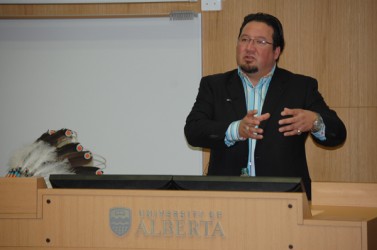Article Origin
Volume
Issue
Year
Derek Nepinak may pre-date the Faculty of Native Studies, but the University of Alberta is proud to claim him as one of their own.
“You see someone who graduated from Native Studies, studied law, become a political major actor on the stage,” said Faculty of Native Studies professor Dr. Frank Tough.
Nepinak, who now serves as Grand Chief with the Manitoba Assembly of Chiefs, completed a First Class Honours Bachelor of Arts degree in Native Studies from the U of A in 2004. He completed a law degree from the University of Saskatchewan and earned a Master degree in Aboriginal governance from the University of Winnipeg.
“The schooling that I did here in Alberta … I was only successful because of my connections to the people that I know. I learned a lot from the Elders here…and it’s from that connection that I was able to balance the academic experience with the connection back to the land, that I was able to become successful in the things that I have done,” said Nepinak.
The Pine Creek First Nation member returned to his alma mater to help commemorate 25 years of the existence of a Native Studies program at the U of A through the establishment of a School of Native Studies in 1988.
In 2006, Native Studies became its own faculty. The U of A boasts the only such faculty in North America.
While the University of Lethbridge has a Department of Native Studies within its Faculty of Arts and Science and the University of Manitoba has Faculty of Arts-Native Studies, Jodi Stonehouse says what the U of A has to offer is much more.
“The difference is we are our own faculty. Degrees are administered under that faculty, so you actually end up with a degree in Native Studies,” said Stonehouse, who has been at the U of A for 12 years, and has both her bachelor and master degrees through the FNS. She now serves as communications and recruitment coordinator for the faculty.
“It’s a huge deal as far as Indigenous people that our knowledge is being recognized as just as legitimate and at the same level as any other faculty here in North America. That who we are as Indigenous people is just as relevant and as important as engineering, medicine,” she said.
The U of A is a leader among post-secondary institutions when it came to commitment to Aboriginal learning and inclusion. It became the first western university to host the Legacy of Hope Foundation’s exhibit 100 Years of Loss: The Residential School System in Canada; the first university in Canada to join the Aboriginal Human Resource Council Leadership Circle; and the first university to have an Indigenous Artist-in-Residence program.
But while university administrators push inclusion, the feeling isn’t always there, says Quetzala Carson, a third-year student in the Faculty of Native Studies.
She points to the tipi recently raised to mark the occasion and situated outside of Pembina Hall, which houses the Faculty of Native Studies.
“If the university was a safe space we wouldn’t find old condoms in there, we wouldn’t find beer bottles in there and it would be respected and it would be respected as the example and as an image of Indigeneity and of the struggle of Indigenous people whose territory that the campus is on now. And it is not respected. The university is still a colonial space even though we are all trying, even though we have decolonized pockets, it is still a colonial structure in which we operate,” said Carson.
She says she agrees with Depinak that the best way to decolonize is to embrace ceremony, but that cannot be done throughout the campus.
“There are students who feel uncomfortable walking on campus during the day, in quad, by themselves, because they don’t feel comfortable within the community on campus and they don’t feel comfortable with the rest of the university population in expressing their traditions and in expressing who they are,” said Carson. “(But) we are working on Indigenizing the academy and working our Indigenous beliefs and our Indigenous methodologies into our research and everything else we do but we’re still not 100 per cent there yet.”
However, Carson, who is Miskito, an Indigenous people in Nicaragua, is quick to point out that Indigenous people are treated better in Canada than they are in her home country. In Nicaragua, she says, racism is blatant and Indigenous people are viewed as inferior.
“I feel so privileged that I am able to exist in a space (in Canada) where I can be proud of my Indigeneity and show my Indigeneity and not have fear of being persecuted,” she said.
Photo caption: Grand Chief Derek Nepinak returned to the University of Alberta as part of the celebration to mark 25 years of a Native Studies program at the post-secondary institution.
- 3196 views

